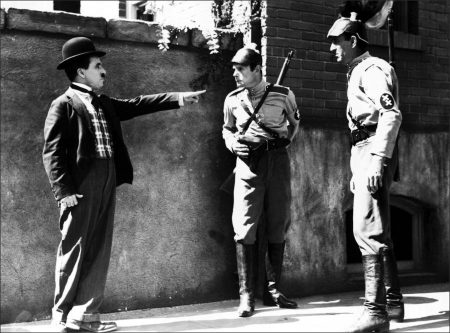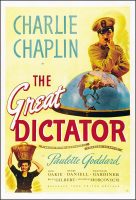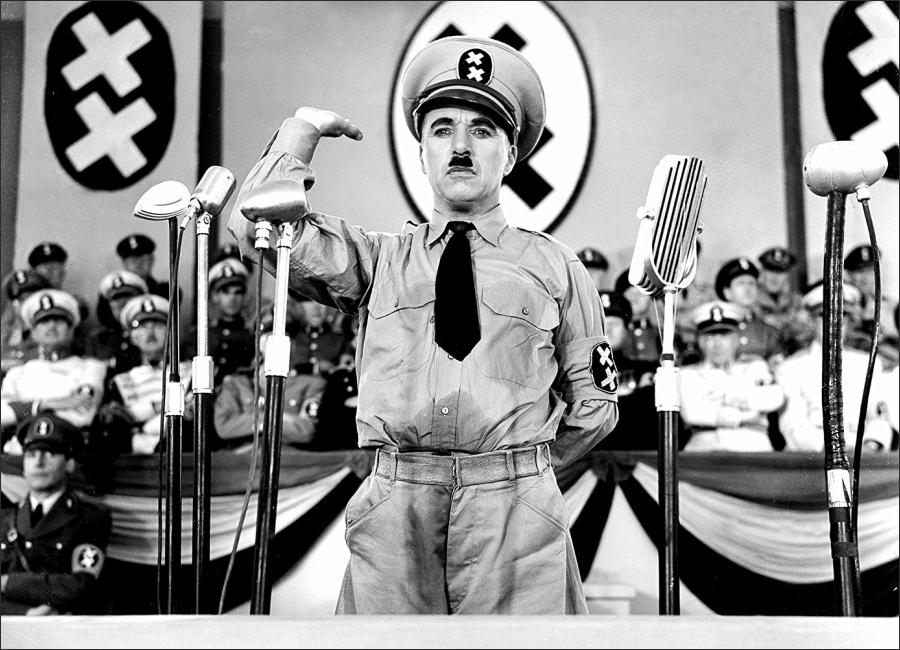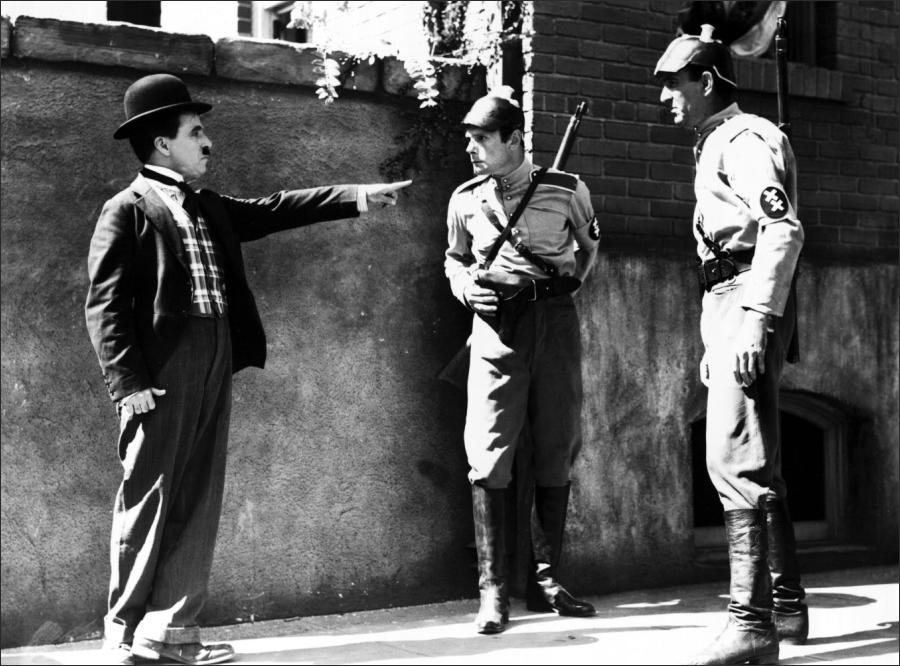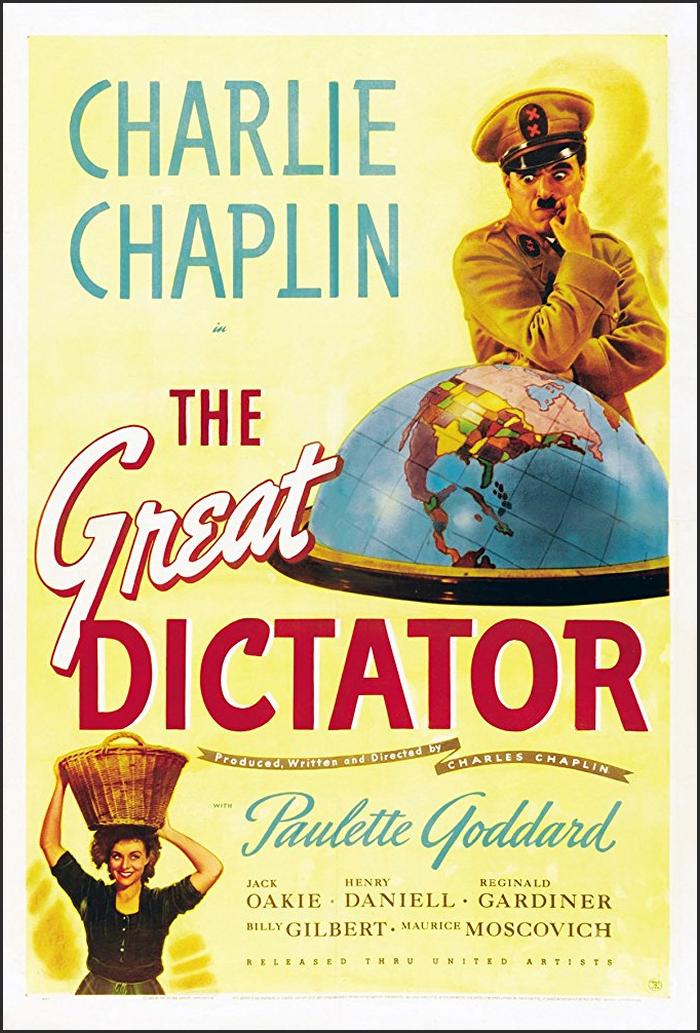The Great Dictator movie storyline. In his first full “talkie” (in a film similar to the Marx Brothers’ Duck Soup (1933)) and his most financially-successful film, Chaplin plays a dual role as: Adenoid Hynkel, the great dictator of the film’s title – the power-mad, despotic ruler and Fooey (Fuhrer) of the fictional European nation of Tomania, and an un-named, humble, amnesiac Jewish barber (with some resemblance to Chaplin’s Little Tramp character who was retired at the end of Modern Times (1936)) who returns years after being a soldier in World War I to discover that his long-abandoned shop is now part of the Jewish ghetto, occupied by thuggish Aryan stormtroopers of the Double Cross (rather than a swastika).
The Jewish barber is mistaken for the country’s tyrannical dictator Hynkel, who is obviously a mocking satire of Adolf Hitler, complete with his squared-off mustache and Nazi-ish uniform. An additional burlesque portrait of Italy’s tyrannical Benito Mussolini is in the character of Benzino Napaloni (Oakie), Dictator of the rival country of Bacteria.
The film’s message was made even more powerful by the satire, making fun of their demagoguery, fascism and anti-Semitism. Chaplin’s bold and controversial parody, with its social and political commentary, was banned in occupied Europe, South America and Ireland. Some believed that Chaplin was trivializing the Nazi’s violent rise to power; however, the film had entered production in 1938, when most Americans viewed Adolf Hitler as an ally (not an enemy), and were opposed to entering WWII…
It was released before the United States’ entry into World War II (in 1941) and before knowledge of the Holocaust. One of the film’s most famous scenes is Hynkel playing with an inflated balloon-globe of Planet Earth in a graceful, ballet-like sequence; also the pudding scene, and the one of the barber shaving a customer in time to a radio broadcast of Brahms’ Hungarian Dance No. 5. The most powerful moment is when the barber (disguised as Hynkel) delivers a six-minute impassioned monologue (often interpreted as Chaplin’s own plea) at the end of the film for peace, hope, human rights, understanding and world tolerance.
The Great Dictator is a 1940 American political satire comedy-drama film written, directed, produced, scored by and starring British comedian Charlie Chaplin, following the tradition of many of his other films. Having been the only Hollywood filmmaker to continue to make silent films well into the period of sound films, this was Chaplin’s first true sound film.
Chaplin’s film advanced a stirring, controversial[4] condemnation of Adolf Hitler, Benito Mussolini, fascism, antisemitism, and the Nazis. At the time of its first release, the United States was still formally at peace with Nazi Germany. Chaplin plays both leading roles: a ruthless fascist dictator and a persecuted Jewish barber.
The Great Dictator (1940)
Directed by: Charles Chaplin
Starring: Charles Chaplin, Paulette Goddard, Jack Oakie, Reginald Gardiner, Henry Daniell, Carter DeHaven, Maurice Moscovitch, Emma Dunn, Bernard Gorcey, Chester Conklin, Hank Mann, Esther Michelson
Screenplay by: Charles Chaplin
Cinematography by: Karl Struss, Roland Totheroh
Film Editing by: Willard Nico, Harold Rice
Set Decoration by: Edward G. Boyle
Art Direction by: J. Russell Spencer
Makeup Department: Ed Voight
Music by: Charles Chaplin, Meredith Willson
Distributed by: United Artists
Release Date: October 15, 1940 (New York), March 7, 1941 (London)
Views: 220

